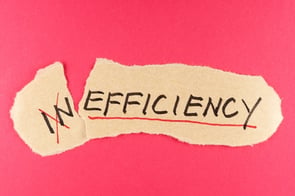 If you were to take a microscope into your kitchen and look at your kitchen countertop, what would you see? More than likely, you would see a lot of microscopic organisms floating around. If you are not diligent in wiping the "germs" away, they will grow, causing illness and added expense in their wake.
If you were to take a microscope into your kitchen and look at your kitchen countertop, what would you see? More than likely, you would see a lot of microscopic organisms floating around. If you are not diligent in wiping the "germs" away, they will grow, causing illness and added expense in their wake.
This same concept applies to warehouse efficiency. Small inefficiencies are much like the microscopic "germs" on your counters. If you are not diligent about finding these inefficiency "germs," they will grow. It can cause your warehouse operation to become ill, and correcting those problems generally causes a big expense.
What "Germs" are Lurking in Your Warehouse?
Let's learn about a few of the common inefficiency "germs" you might see in your warehouse.
- Not labeling items clearly
Taking the time to label every item that comes into the warehouse helps make every operation after that more efficient. Labeled products should go into labeled slots on labeled shelves. Additionally, each labeled bin, slot, and shelf should be associated with the appropriate products in the WMS. - Not tracking inventory
If you cannot identify where a particular product is, how much of it you have in real-time, and when you need to reorder it, your inventory tracking process fails to be efficient and runs a high risk of errors. - Not following processes
Processes, when created and followed, should help workers increase accuracy and decrease error. However, when processes are not followed, the reverse happens: errors increase and accuracy decreases. Nothing can be tracked or accounted for, and it runs the risk of doing work twice to make up for mistakes, delays, and poor work performances. - Not cycle counting
Taking a complete physical inventory of your warehouse means shutting down your entire operation. This is a warehouse efficiency killer. However, implementing an automated Warehouse Management System (WMS) gives you the opportunity to cycle count all items within the warehouse, keeping your inventory accurate and tracked in real-time without downtime. - Not cleaning the premises
Cleaning seems like the last thing a warehouse worker should be worried about – there are orders to fill and products to put away! However, the task of cleaning helps maintain warehouse efficiency. It keeps pathways clear and safe. It keeps products put away. It helps uncover misplaced inventory, unfinished orders, and damaged goods. - Not giving your employees enough room to work
Many warehouses suffer the mistake of trying to cram too many shelves into limited space, leaving very little room for people and forklifts. These cramped quarters hinder efficiency by making it difficult to maneuver aisles. This issue slows processes, runs a greater risk of damage to stock, and increases the chances of worker injuries. - Not double checking orders
Did you know that the cost of reprocessing an incorrect order is more than twice the cost of doing it right the first time? Taking the time to double check an order will save both time and money as well as result in improved customer service. - Not doing today's work today
If product is received, it should be put away on the shelf before the shift ends. If an order is active in the system, it should be picked and packed for shipping by the end of the day or associated shipping period. Without doing so, orders may remain incomplete, be shipped late, or be incorrectly picked.
If you don't put priority on wiping out these "inefficiency germs" you run the risk of allowing them to take hold of your warehouse operations. The results may start out as a minor illness, but will become a major plague quite rapidly.



